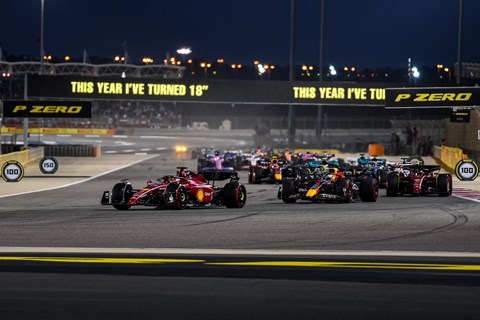► F1 is back in 2022
► And so is Ferrari
► Mercedes profit from Red Bull double DNF
Formula One is back, but not as we know it. New rules and regulations have been introduced to make for closer, more competitive racing – and they’ve given the grid a reshuffle in the process. By Sunday evening, it was clear that Ferrari is now the team to beat in this all-new era – but there were stories up and down the field. So, what to make of this new era of F1? Here’s what I learnt after the first 57 laps in 2022.

1. The cars look great, but slow
F1’s new rules have made for dramatic-looking cars, but it’s fair to say they don’t look particularly agile. After launching off the line, the 2022 cars sauntered into the first corner, and it looked a bit embarrassing. It’s a two-sided issue; at 798kg the cars are heavier than ever, and ground effect means the cars only produce more downforce at speed.
The result? The rather beautiful Ferrari F1-75 looked like a London bus in T1, before turning into a racecar later in the lap. F1 promised us close racing, not fast racing

2. The racing was legitimately close
Put the slow-mo visuals to one side, and it’s fair to say this was one of the most action-packed races we’ve had in a while. Braking zones were even more crucial, cars looked a handful in traction zones and ultimately battles were closer and longer too. DRS wasn’t as overpowered as some feared, and it seemed to do a good job of keeping cars together.
It remains to be seen if further downforce and updates will negate the effect of the new rules, and we’ll need to see them in action at other tracks – but so far, the signs are good.
3. Charles 1 – 0 Max
After scampering off in the opening laps, an early pit stop brought Verstappen’s Red Bull into contention and soon we got to see some Max dive-bombing. The Red Bull seemed to have far more speed at the end of the straight, and it meant Max charged down the inside a handful of times – once giving himself a flatspot in the process.

Charles calmly retook the place using DRS every time, and it was a great illustration of the disparity in racing IQ (not speed) between the two. After the race, Leclerc revealed he was braking early so he had DRS to repass the Red Bull later. Thoroughly outthought in Bahrain, Max’s ‘full send’ tactics didn’t work at all in this race. How long until Max reverts to brute force?
4. Mercedes really isn’t sandbagging
Mercedes usually manages to turn poor tests around, but this time the team’s compromised preparation has rolled into the season proper.
The fundamental problem is bouncing or porpoising; caused by the way the car’s ride height and downforce react with each other. It can be fixed right now, but not at the expense of performance, and only a longer-term solution will preserve downforce while removing bouncing.

With that in mind, the Silver Arrows were running in a compromised configuration on Sunday; no longer bouncing, but down on top speed and overall performance to the tune of 0.5 to 0.75 seconds per lap. Worse still, this caused elevated tyre degradation compared to the top teams.
A 3rd and 4th were much better than the 5th and 6th the team were expecting, and it won’t be able to rely on Red Bull DNFs in the coming weeks. If the W13’s problems aren’t solved soon, both Ferrari and Red Bull will be out of reach.
It could be worse though, bouncing is costing Aston Martin even more time.
5. McLaren falls back
McLaren looked like one of the most sorted teams in the first test, and despite some issues in the second, nobody expected things to go this badly. No points and a 14th and 15th was a disaster for the Woking team after such a promising 2021.
The worst bit? Both drivers are reporting good balance and handling; that suggests the issue is just a total lack of downforce and performance. Which position would you rather be in? Having a slow car working as intended, or a slow car that’s a quick car after its issues are solved.
6. Magnussen and Bottas
After so much discussion around pay drivers, it was good to see talent rise to the top in Bahrain. Both Bottas and Magnussen put in strong showings, proving why they were employed by Mercedes and Haas respectively. Both drivers performed well on the Saturday, with Bottas slotting into 6th and Magnussen into 7th – and Sunday went well too.
Although Bottas had his customary poor start, he soon made his way back to 6th. In contrast, Magnussen launched off the line before holding on for 5th. Both have a multi-year contract and they’re a much-needed injection of quality into the midfield.

7. 0 points for Red Bull
Despite having a good pre-season test and racking up the miles, two technical faults left Red Bull with no points from Bahrain. After being outraced by Charles Leclerc, Verstappen’s last pit stop damaged his steering, and soon he experienced a mechanical issue. Just a few laps later the same fate caused Perez’s sister car to spin, allowing a podium for Hamilton.
Paddock chat suggests the fault on both cars lies not with the Red Bull powertrain, but with a spec fuel pump all cars are required to run. However, it remains to be seen why other teams didn’t suffer the same fate…